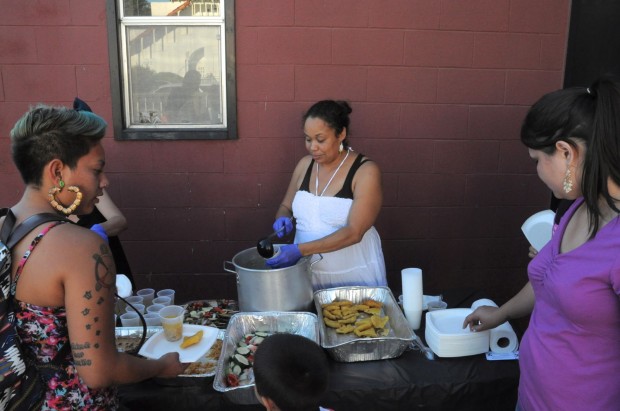
By Terray Sylvester, Oakland North
On a sunny afternoon, Oakland chef Crystal Wahpepah is measuring her success in many portions: a scoop of walnut pudding, a hunk of salmon with roasted zucchini, a ladleful of summer squash stew in a plastic cup. The occasion is the opening of a new Native American Health Center office in Richmond, and the food is the fruit of Wahpepah’s five-year effort to build a business.
Her catering service, Wahpepah’s Kitchen, specializes in traditional Native American cuisine, particularly recipes from her Pomo and Kickapoo heritage.
“Right now it’s a good time for my menu because it’s harvest time,” she says, handing a piece of pumpkin fry bread to a guest. “I like to know where 90 percent, maybe 100 percent of my food comes from.”
In fact, she’d picked the pumpkins over the weekend at a garden she keeps with friends in Sebastopol.
Wahpepah has been passionate about cooking since she was a child, when she would visit the Kickapoo Nation in Oklahoma and help her grandmother make meals of sweet corn, bison, summer squash and pumpkin. She also recalls the recipes she learned in the home of her uncle, who was active in the American Indian Movement in Oakland and hosted visitors from tribes across the nation.
“Those are the best memories of my life,” she said. “I learned what food the Sioux made, what the Apaches made.”
Native American-owned businesses are a rarity in the Bay Area, making up just 0.9 percent of the firms in the region. In Oakland, where Native Americans are less than one percent of the population, the number of businesses they own is low enough not to register in Census Bureau tallies.
The lack of Native American eateries is particularly striking given the diversity of the Bay Area food scene, which places a premium on local and ethnic foods. So far, Wahpepa says, she knows of no one else who’s making dishes like her savory potatoes wrapped in seaweed from the Pacific Coast, or her lemongrass tea from the Great Plains.
According to Tracy Stanhoff, president of the California American Indian Chamber of Commerce, the dearth of Native-owned business is due in part to a catch-22: when few Native Americans run businesses, would-be Native entrepreneurs struggle to find people who can offer them advice or financial help.
“There is a lack of mentors and a lot of first-generation business owners who are scraping to get by,” she said.
But Stanhoff doesn’t think urban Indian entrepreneurs face significantly different obstacles than other ethnic minorities. On tribal lands, tangled property laws and an absence of financial institutions mean that credit and collateral are often in chronically short supply. But in cities, Stanhoff says, the situation is not the same.
“There are barriers, but in urban areas it’s not too much different than for a regular small business,” she said. “We’re generally an underserved population and lack access to capital, but it can be done.”
Wahpepah grew up in East Oakland and studied marketing at American Indian College in Phoenix, Ariz., and, briefly, cooking at the California Culinary Academy. But with little in the way of capital, she struggled to get her business off the ground until she was accepted into La Cocina,an incubator program in San Francisco designed for low-income entrepreneurs.
At La Cocina, she learned about loans available through Kiva Zip, an offshoot of the successful micro-loan website Kiva.org. With an endorsement from Oakland’s Native American Health Center, she secured a $5,000 interest-free loan to help her pay for business permits, cooking space, equipment and other start-up costs.
“It helped tremendously,” she said of the Kiva Zip loan, which she received in December 2012. “I love Kiva because you can express yourself. Instead of looking at your credit, they look at your passion.”
She currently supplements her catering by teaching classes on Native American foods.
“The dream is to make Native Americans and non-Native Americans aware of how beautiful our food is, and how healthy too,” she says. “We should be proud.”
